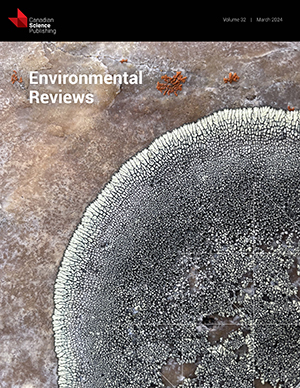Wetlands as integral parts of surface water – groundwater interactions in the Athabasca Oil Sands Area: review and synthesis
IF 5.1
3区 环境科学与生态学
Q1 Environmental Science
引用次数: 0
Abstract
Wetlands comprise unique water storage and conveyance mechanisms that maintain landscape integrity under the sub-humid climate in the Athabasca Oil Sands Area. In addition to their internal function, wetlands support a two-way hydrological connection to adjacent uplands and provide water for downstream water courses. Understanding the role of wetlands as integral parts of surface water (SW) – groundwater (GW) exchange can provide insights into the functioning of the hydrological system as a whole and contribute to thoughtful water management strategies and better coordination of monitoring efforts in the areas affected by oil sands (OS) activities. As such, this paper summarizes the current state of hydrological knowledge on the role of wetlands in SW – GW interactions based on studies conducted within the Western Boreal Plains. In particular, the role of wetland soils and their properties in SW – GW interactions, the effects of wetlands on landscape hydrological connectivity and watershed runoff, and features of ‘wetland – aquifer” and “wetland – open waterbody” interactions were reviewed. Given that alteration of SW – GW interactions in wetlands can occur as a result of anthropogenic disturbances, coordination of GW, SW, and wetland monitoring efforts and targeting areas where increased SW – GW exchange occurs would be beneficial for the economic and logistical efficiency of the OS monitoring network.湿地作为阿萨巴斯卡油砂地区地表水-地下水相互作用的组成部分:回顾与综述
湿地包括独特的储水和输送机制,在亚湿润气候下保持阿萨巴斯卡油砂区景观的完整性。除了其内部功能外,湿地还支持与邻近高地的双向水文连接,并为下游水道提供水。了解湿地作为地表水(SW) -地下水(GW)交换的组成部分的作用,可以深入了解整个水文系统的功能,有助于制定周到的水资源管理战略,并更好地协调受油砂活动影响地区的监测工作。因此,本文基于在西部北方平原进行的研究,总结了湿地在SW - GW相互作用中的作用的水文知识现状。重点综述了湿地土壤在西南—西南相互作用中的作用及其性质,湿地对景观水文连通性和流域径流的影响,以及“湿地—含水层”和“湿地—开放水体”相互作用的特征。鉴于湿地中SW - GW相互作用的改变可能是人为干扰的结果,因此,GW、SW和湿地监测工作的协调,以及针对SW - GW交换增加的地区,将有利于生态系统监测网络的经济和后勤效率。
本文章由计算机程序翻译,如有差异,请以英文原文为准。
求助全文
约1分钟内获得全文
求助全文
来源期刊

Environmental Reviews
ENVIRONMENTAL SCIENCES-
CiteScore
9.80
自引率
3.50%
发文量
45
审稿时长
>12 weeks
期刊介绍:
Published since 1993, Environmental Reviews is a quarterly journal that presents authoritative literature reviews on a wide range of environmental science and associated environmental studies topics, with emphasis on the effects on and response of both natural and manmade ecosystems to anthropogenic stress. The authorship and scope are international, with critical literature reviews submitted and invited on such topics as sustainability, water supply management, climate change, harvesting impacts, acid rain, pesticide use, lake acidification, air and marine pollution, oil and gas development, biological control, food chain biomagnification, rehabilitation of polluted aquatic systems, erosion, forestry, bio-indicators of environmental stress, conservation of biodiversity, and many other environmental issues.
 求助内容:
求助内容: 应助结果提醒方式:
应助结果提醒方式:


